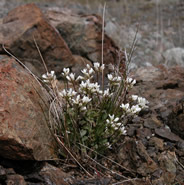Kneeland Prairie penny-cress facts for kids
Quick facts for kids Kneeland Prairie penny-cress |
|
|---|---|
 |
|
| Conservation status | |
| Scientific classification | |
| Genus: |
Thlaspi
|
| Species: |
californicum
|
The Kneeland Prairie penny-cress (scientific name: Thlaspi californicum) is a very rare flowering plant. It belongs to the Brassicaceae family, which includes plants like mustard. This special plant only grows in one small area in Humboldt County, California. It is an endangered species, meaning it is at risk of disappearing forever. This is mainly because of new buildings and roads.
Contents
About the Kneeland Prairie Penny-cress
What's in a Name?
The scientific name of this plant can be a bit confusing! Scientists are still trying to decide its exact classification. You might see it called Thlaspi californicum. But some experts also call it Thlaspi montanum var. californicum, Noccaea californica, or Noccaea fendleri ssp. californica. These different names are called synonyms.
Plant Description
This plant is a perennial herb. This means it lives for more than two years. It usually grows to about 10 centimeters (4 inches) tall. Some plants can be as small as 1 centimeter (0.4 inches) or as tall as 20 centimeters (8 inches).
It has leaves shaped like spatulas near its base. These lower leaves are a few centimeters long. There are also a few smaller leaves higher up on the stem.
Flowers and Fruit
The plant produces flowers that look like tiny mustard blooms. They grow in a cluster called a raceme. Each flower has white, spoon-shaped petals. These petals are just under a centimeter long. After the flowers, the plant forms a fruit called a silique.
How it Reproduces
The Kneeland Prairie penny-cress often reproduces in a special way. It can make copies of itself without seeds. This is called cloning or vegetative reproduction. This means new plants grow directly from parts of the parent plant.
Where it Lives
As of the year 2000, there was only one known group of these plants left. It lives near the Kneeland Airport on the Kneeland Prairie. This area is close to Eureka in Humboldt County.
The plant grows in three separate groups, or colonies. These colonies are found on special rocky areas called outcrops. These outcrops are made of serpentine rock. Two of these colonies are separated by the Kneeland Airport itself. The Kneeland Prairie penny-cress can only grow in the unique serpentine soil found in this area.
Threats to the Plant
The Kneeland Prairie penny-cress is in danger. Its habitat is threatened by new buildings and roads. These developments are happening near the airport and other nearby facilities. This includes a base for helitack crews, who fight wildfires.
In the last few decades, the amount of land where this plant can grow has shrunk a lot. It has decreased by 50% or even up to 70%. This development has also caused habitat fragmentation. This means the plant's home is broken into smaller pieces. The airport and a road now cut right through the plant's population.
There are plans to expand the airport. This includes building a new parking lot. These projects could make the problem even worse. They might reduce the plant's suitable habitat even more. Protecting this rare plant and its unique home is very important.


